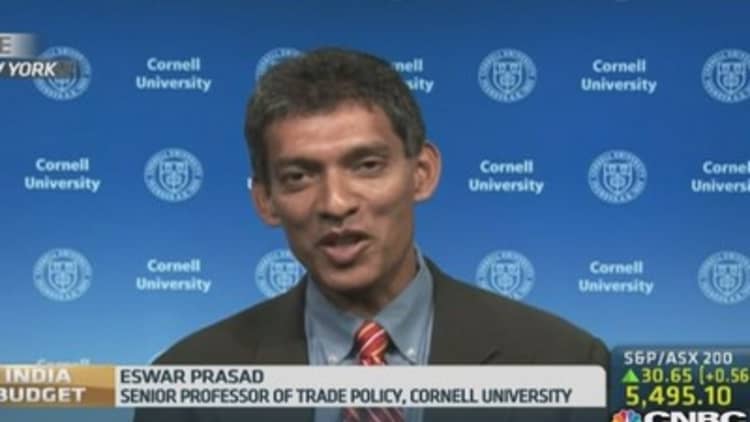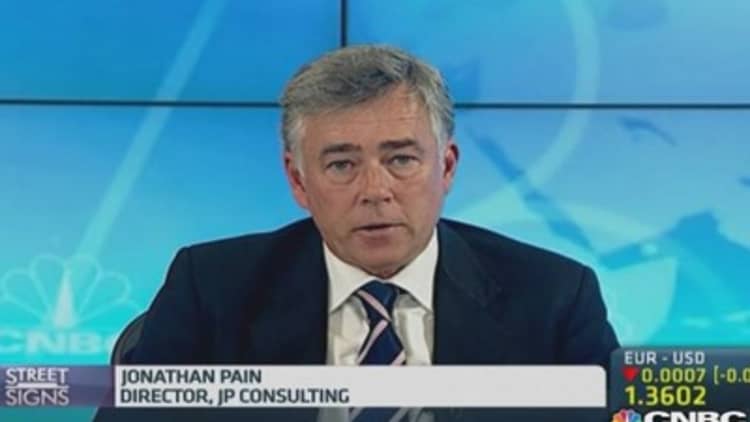
The new Indian government's debut budget – which set out ambitious fiscal consolidation and economic growth targets – is a step in the right direction, but lacks crucial details on how it will turn its aspirations for "a vibrant and strong" economy into reality, say economists.
Thursday's budget was a major test of new Prime Minister Narendra Modi's commitment to carrying out the reforms needed to get Asia's third-largest economy back on track.
"Our big picture reading from the budget statement is that policy makers are moving in the right direction… However, we believe that the reform agenda remains under construction," Chetan Ahya, economist at Morgan Stanley wrote in a report.
Read MoreModi budgets for Indian growth, to curb deficit
"The government will have to provide the finer details and implementation plans of today's announcements and will need to articulate its plans on other critical reforms," he said.
Delivering the budget, Finance Minister Arun Jaitley said the government aims to get growth back up to 7-8 percent in the next 3-4 years – levels not seen since 2011. The economy expanded 4.7 percent in the fiscal year that ended March 31, the second straight year of sub-5 percent growth.
The fiscal deficit target, meanwhile, was left at 4.1 percent of gross domestic product (GDP) for the current fiscal year ended March 2015, a positive surprise as many economists expected an upward revision to take into account unpaid subsidy bills left behind by the previous government.
Read MoreModi's first budget: Here's what to watch for
The government looks to reduce the deficit to 3.6 and 3 percent of GDP in fiscal 2016 and 2017, respectively, from 4.6 percent in fiscal 2014.
Economists say while the government's commitment to maintaining the trend of fiscal consolidation is positive, its targets appear unrealistic.
"The fiscal deficit target of 4.1 percent of GDP may be difficult to achieve given optimistic assumptions on revenue growth, and 4.3 percent of GDP may be a more realistic number. Further, the budget did not specify measures on how the medium-term consolidation path would be achieved," said Tushar Poddar, economist at Goldman Sachs.
On the expenditure side, hopes were that the government would detail plans to scale back subsidies – a large contributor to the budget deficit. However, it merely promised "better targeting" of food and petroleum subsides.
Read MoreIs Carrefour's India exit a setback for Modi?
India's subsidy bill increased significantly over the past decade. Spending on subsidies rose to 16 percent of the budget in the fiscal year ended March 2013 from 9 percent in 2004.
"The budget is less ambitious in reducing the subsidy burden," said Standard & Poor's credit analyst Agost Benard. "It promises better targeting of food and petroleum subsides. However, it is not yet clear how that will be achieved, or how much saving it would bring."
Moreover the total budget for food subsidies is the same as that for fertilizers, and higher than in the previous government's budget.

Bright spots
While the budget disappointed on some fronts, it delivered on others including measures to attract capital inflows – including raising the foreign direct investment (FDI) limit in the defense and insurance sectors was raised to 49 percent from 26 percent – and structural reforms to boost the manufacturing sector.
The measures include creating Special Economic Zones, excise duty cuts for labor intensive sectors such as food processing and footwear and a 100 billion rupee venture capital fund for small and medium enterprises, according to Goldman Sachs.
Read MoreMarket that's up 22% holds its breath Thursday
"We think the focus on boosting labor intensive manufacturing is critical for India's long-term growth strategy, and we view them positively," said Poddar.
In addition, the government made sizable allocations to the development of infrastructure, including improving road and port connectivity. Addressing India's supply-side bottlenecks is a critical factor for unleashing the country's growth potential.
The ministry of road transport and highways, for example, was allocated Rs.37,880 crore compared with Rs.33,050 crore in the previous fiscal year.
Taking the positive and pitfalls of the budget into consideration, Vikas Sharma, president and CEO of Nomura Financial Advisory & Securities said, "This is a budget that walks the fine line between the twin and somewhat contrasting objectives of higher growth and fiscal imperatives with great finesse. It provides enough incentive and fillip to the private sector to start the investment cycle and take the growth to a much higher path."


